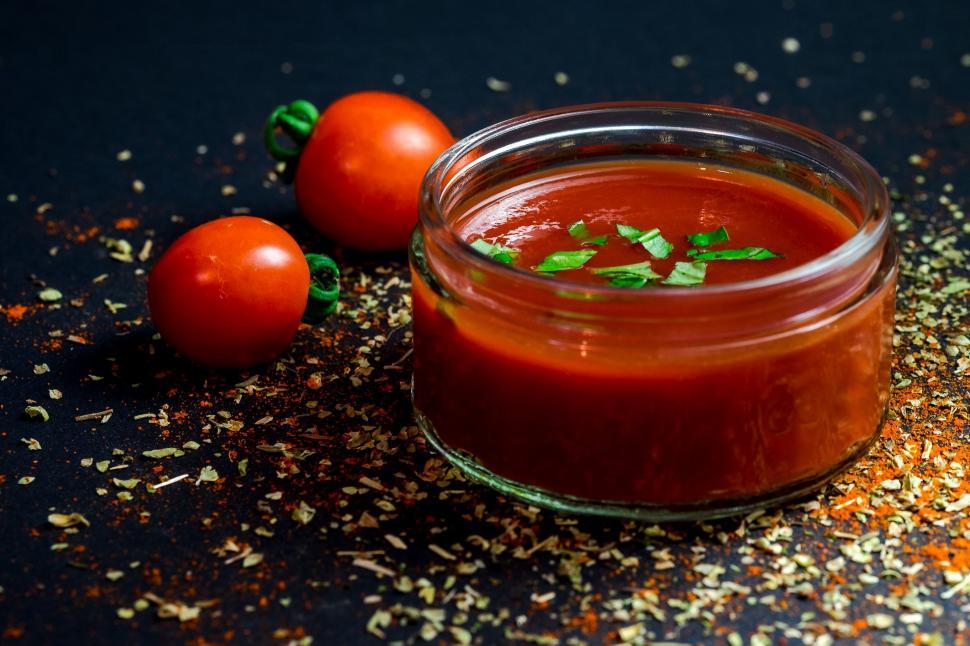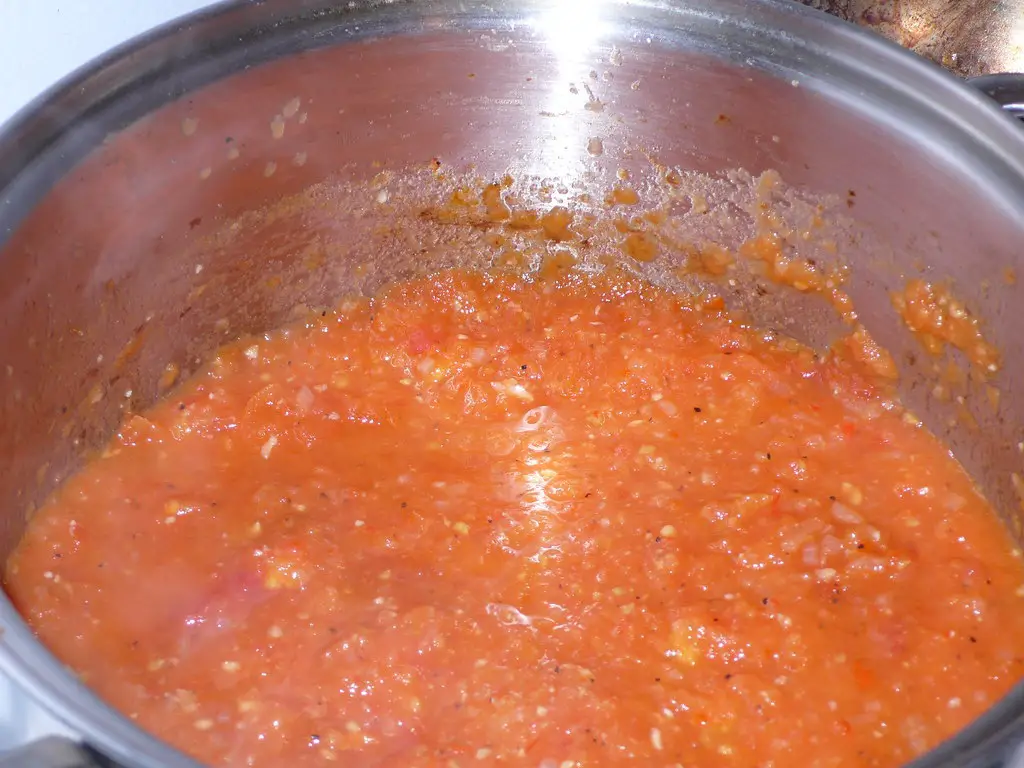Table of Contents
Hot sauce adds a fiery kick to any dish. It’s beloved by spice enthusiasts worldwide.
Craving that perfect blend of heat and flavor? Making your own hot sauce at home is a fun and rewarding experience. You control the ingredients, adjusting the spice level to your liking. Imagine having a homemade hot sauce that’s unique to your taste.
It’s easier than you think! With just a few fresh ingredients and some simple steps, you can create a hot sauce that will impress your friends and family. Whether you’re a heat-seeker or just enjoy a little zing, this recipe guide will help you craft a hot sauce that’s just right. Ready to spice things up? Let’s dive in!

Ingredients List
Creating your own Homemade Hot Sauce can be a fun and rewarding experience. Knowing the right ingredients will help you make a delicious Spicy Sauce Recipe that suits your taste. This guide will walk you through the essential elements needed to craft your perfect Diy Hot Sauce. From fresh peppers to vinegar options and additional spices, we’ve got you covered.
Perfect Beef Chilli Recipe: Mouthwatering Comfort Food
Fresh Peppers
Fresh peppers are the heart of any Hot Pepper Sauce. They provide the heat and flavor. Choosing the right peppers is crucial. Different peppers offer different levels of spiciness.
Here are some popular choices:
- Jalapeños: Mild heat, great for beginners.
- Habaneros: Very spicy, ideal for experienced chili lovers.
- Serranos: Moderate heat, perfect balance.
- Ghost Peppers: Extremely hot, proceed with caution.
Each pepper has a unique taste. Mixing various peppers can create a complex Chili Pepper Blend. Experimenting with different combinations will help you find your favorite flavor profile. Freshness matters. Use fresh peppers for the best taste in your Fermented Hot Sauce.
Also Read: Chili Paste Recipe: Spice Up Your Dishes with Homemade Flavor
Vinegar Options
Vinegar For Hot Sauce acts as a preservative and adds tanginess. It balances the heat from the peppers. There are several types of vinegar you can use:
| Type | Flavor Profile |
|---|---|
| Apple Cider Vinegar | Sweet and fruity |
| White Vinegar | Sharp and clean |
| Red Wine Vinegar | Rich and robust |
| Rice Vinegar | Mild and slightly sweet |
Choosing the right vinegar can change the overall taste of your Garlic Hot Sauce. Try different types to see which one you prefer. Some people mix several vinegars for a unique taste. This adds depth to the sauce. Don’t be afraid to experiment. Your perfect Flavoring Spices For Sauce might include a blend of vinegars.
Additional Spices
Adding spices enhances the flavor of your Homemade Hot Sauce. Basic spices to consider:
- Garlic: Adds a savory depth.
- Onion: Provides sweetness and complexity.
- Cumin: Earthy taste, pairs well with peppers.
- Oregano: Herbal notes, great for balance.
- Salt: Essential for taste enhancement.
These spices can be adjusted to suit your preferences. Combining them with your chosen peppers and vinegar creates a rich and flavorful Spicy Sauce Recipe. Always taste your sauce as you add spices. This will help you achieve the desired flavor. Remember, the key to a great sauce is balance. Too much of one spice can overpower the others. Aim for harmony in your Best Hot Sauce Ingredients.
Preparation Steps

Making your own hot sauce at home is a fun and rewarding process. You can create a sauce that matches your taste by using different peppers and ingredients. Follow these preparation steps to make your perfect hot sauce.
Chopping Peppers
First, you need to prepare the peppers. This step is important because the type of pepper you choose will determine the heat level of your sauce. Some popular pepper varieties include:
- Jalapeños for mild heat
- Serranos for medium heat
- Habaneros for high heat
Chopping peppers can be done in a few simple steps:
- Wear gloves to protect your hands from chili pepper heat.
- Wash the peppers thoroughly to remove any dirt.
- Remove the stems and seeds if you want a milder sauce.
- Chop the peppers into small pieces for easier blending later.
Remember to be careful with your eyes and skin. Peppers can cause irritation.
Mixing Ingredients
Now that your peppers are ready, it’s time to mix the other ingredients. This is where you can get creative with your spicy sauce ingredients. Some common ingredients include:
- Vinegar for acidity
- Garlic for flavor
- Salt for taste
- Onion for sweetness
- Spices like cumin or oregano for extra flavor
Here’s a simple table to help you balance the flavors:
| Ingredient | Amount |
|---|---|
| Peppers | 1 cup, chopped |
| Vinegar | 1/2 cup |
| Garlic | 2 cloves, minced |
| Salt | 1 tsp |
| Onion | 1/4 cup, chopped |
| Spices | 1/2 tsp each |
Mix these ingredients in a bowl. This will help blend the flavors before you start the next step. Flavor balancing is key to a tasty sauce.
Blending Process
Once your ingredients are mixed, it’s time to blend them into a smooth sauce. This step will create the final texture of your homemade hot sauce. Follow these steps:
- Pour the mixed ingredients into a blender.
- Start blending on low speed to combine the ingredients.
- Gradually increase the speed to high.
- Blend until the sauce is smooth and no chunks remain.
If the sauce is too thick, you can add more vinegar or water. Blend again until you reach the desired consistency. Sauce storage tips include using glass bottles or jars to keep the sauce fresh. Store it in the refrigerator to maintain its flavor.
Congratulations! You have made your own diy hot sauce. Enjoy it with your favorite foods and share it with friends.

Fermentation Process
Making your own Chili Pepper Sauce at home is a fun and rewarding process. The Fermentation Process is key to developing rich flavors in your homemade hot sauce. This guide will help you understand the steps needed to create a delicious and spicy condiment recipe. Let’s dive into the details of choosing the right container, determining the fermentation duration, and recognizing the signs of fermentation.
Choosing The Right Container
Picking the right container is crucial for the fermentation process. The container must be clean and non-reactive. Glass, ceramic, or food-grade plastic are the best options. Here are some points to consider:
- Glass Jars: Easy to sterilize and available in various sizes.
- Ceramic Crocks: Traditional choice, keeps temperature stable.
- Food-grade Plastic: Lightweight and durable but ensure it’s BPA-free.
Each type has its benefits, but Fermentation Jars with airlocks are highly recommended. They allow gases to escape without letting air in. This prevents spoilage and contamination. Always sterilize your container before use to ensure a safe fermentation process.
Fermentation Duration
The duration of fermentation affects the flavor and heat of your hot sauce. It usually ranges from one week to several months. Several factors influence the time needed:
| Factor | Effect on Duration |
|---|---|
| Temperature | Warmer temperatures speed up fermentation. |
| Salt Content | Higher salt slows down the process. |
| Ingredient Proportions | More sugar can speed up fermentation. |
Check your sauce regularly. Taste it to decide if it has reached your desired flavor. A longer fermentation results in a more complex taste. Experiment to find your perfect balance.
Signs Of Fermentation
Knowing when your sauce is fermenting properly is important. Here are some signs to look for:
- Bubbles: Small bubbles should be visible in the jar.
- Smell: A sour, tangy smell indicates active fermentation.
- Color Change: The mixture often becomes duller in color.
If you see mold, discard the batch. Mold can ruin the flavor and make the sauce unsafe. A healthy fermentation will have a clean, acidic smell. The bubbles and color change indicate the growth of good bacteria. These signs mean your Vinegar-Based Sauce is developing its unique flavor. Enjoy the process and create your own Recipe Variations!
Storage Tips
Hot sauce can add a burst of flavor to any dish. Making your own hot sauce allows you to control the ingredients. It also helps you customize the heat levels. But once you’ve made it, storing it properly is key. Proper storage keeps your sauce fresh and safe to eat.
Bottling Your Sauce
Proper bottling is crucial for homemade hot sauce. Clean and sterilize your bottles first. This step prevents bacteria growth. Use glass bottles with tight lids. These are the best for storing hot sauce.
Follow these steps for bottling:
- Wash bottles with soap and water.
- Boil bottles in water for 10 minutes.
- Let them dry completely before use.
Consider using a funnel to pour the sauce. It avoids spills and keeps things clean. Fill the bottles, leaving a bit of space at the top. Seal the bottles tightly. Label them with the date of bottling.
Using Sauce Bottling Techniques ensures your sauce stays fresh. It also helps in tracking the age of the sauce.
Best Storage Conditions
Storage conditions impact the quality of your hot sauce. Keep your sauce in a cool, dark place. Avoid direct sunlight. It can degrade the sauce. A pantry or cupboard works well for storage.
Refrigeration is another good option. It extends the shelf life of your sauce. Keep the bottle sealed when not in use. This prevents contamination.
Here are some key points:
- Store in a cool, dark place.
- Refrigerate for longer shelf life.
- Keep the bottle sealed.
These Food Preservation Methods help maintain the flavor and safety of your hot sauce. Proper storage also keeps the heat levels consistent over time.
Shelf Life And Usage
Understanding the shelf life of your hot sauce is important. Homemade hot sauce can last for months. Proper storage extends this period. Generally, a well-made sauce lasts 6 to 12 months.
Check for signs of spoilage. Mold, off smells, or changes in color are red flags. If you notice these, it’s best to discard the sauce. Always use clean utensils when serving the sauce. This prevents contamination.
Here’s a simple table for shelf life based on storage:
| Storage Method | Shelf Life |
|---|---|
| Pantry | 6 months |
| Refrigerator | 12 months |
Cooking With Hot Sauce adds depth to dishes. Use it in marinades, soups, or as a condiment. Always keep an eye on the sauce’s condition. Enjoy the flavor and heat in your meals.
Frequently Asked Questions
What Are The Basic Ingredients Of Hot Sauce?
The basic ingredients of hot sauce are chili peppers, vinegar, and salt. Some recipes may also include garlic and other spices.
How To Create Your Own Hot Sauce?
To create your own hot sauce, blend peppers, vinegar, garlic, and salt. Simmer for 10 minutes. Cool, then bottle it. Adjust ingredients to taste. Enjoy your homemade hot sauce!
What Vinegar To Use For Hot Sauce?
Use white vinegar or apple cider vinegar for hot sauce. They enhance flavor and act as preservatives. Both are popular choices.
Do You Need Fda Approval To Sell Hot Sauce?
No, you don’t need FDA approval to sell hot sauce. However, it must comply with FDA labeling and safety regulations.
What Ingredients Are Needed For Hot Sauce?
You need chili peppers, vinegar, garlic, salt, and water. Optional: sugar, lime juice.
Conclusion
Enjoy making your own hot sauce at home. It’s easy and fun. Adjust the spices to match your taste. Store it in a glass bottle for freshness. Share it with friends and family. They’ll love the unique flavor. Making hot sauce is a rewarding experience.
It adds a personal touch to your meals. Try it today and spice up your food. Happy cooking and enjoy the heat!


